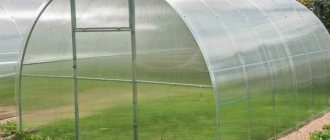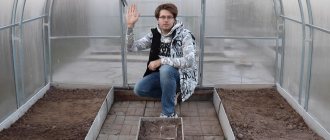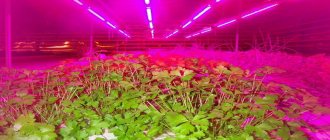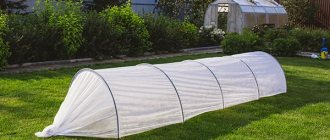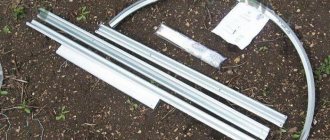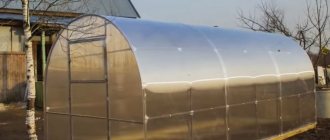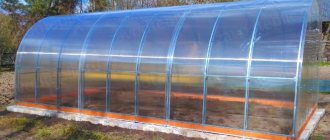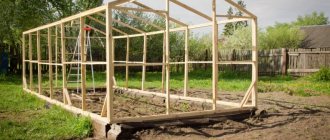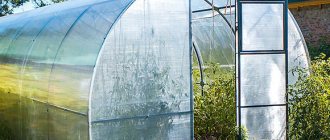Are you already fluent in the technology of growing cucumbers, tomatoes, and peppers? Surely, you are devoted to vegetable growing with all your heart, and therefore you will want to solve a more difficult problem. How about growing artichokes, horned melons, melon pears.
If you have a polycarbonate greenhouse, you can handle these tasks. The conditions in the greenhouse are suitable; you just need to choose the crops to experiment with and get to know them better.
Conditions
To get a rich harvest of tropical fruits, it is necessary to create a microclimate in the greenhouse that is close to the conditions of the tropics. It is necessary to maintain a high temperature, optimal humidity, and provide the plants with a large amount of light. At the same time, it is important to provide regular ventilation to the fruit so that burns do not occur on the plants.
To get a rich harvest of tropical fruits, it is necessary to create a microclimate in the greenhouse that is close to tropical conditions
Pomegranate
Pomegranate is a shrub that grows up to 2 meters in height. This bright berry grows in great abundance in the Crimea, Krasnodar Territory, and in the warm and hot regions of the North Caucasus. Now there are frost-resistant varieties that can withstand temperatures down to -17 degrees, but growing them in central Russia is very difficult. The most popular method of growing pomegranate is using cuttings; it gives an almost 100% guarantee of harvest.
Greenhouse requirements
A greenhouse in which exotic fruits are grown must meet the following requirements:
- wall material. The best option is polycarbonate, glass. The coating should be double or triple. This will help retain heat inside the structure and also protect the plants from cold air;
- moisture resistance. Tropical plants require large amounts of liquid for proper growth and development. Therefore, a high level of humidity is maintained inside the greenhouse. Therefore, materials for construction must be moisture resistant. For this reason, you cannot use wood that will quickly become unusable. If metal elements are used, they are treated with a special compound that prevents the formation of moisture;
Tropical plants require large amounts of liquid for proper growth and development.
- arrangement of the heating system. The optimal temperature for exotic fruits in the daytime is from +250C, at night – from +130C, depending on the type of plant. Only heating devices help to ensure such indicators in the central regions. It is recommended to use gas and electric devices. Oil-based and pyrolysis devices are not used to heat the greenhouse, as they emit harmful substances that have a negative impact on crops. The heating system pipes are placed around the entire perimeter of the greenhouse. They should not touch the plants, as this will cause burns. Pipes are also located at a distance from the walls of the structure, since high temperatures can lead to deformation and cracking of materials;
- presence of windows. Tropical plants need regular ventilation. In hot weather, the temperature inside the structure can reach +500C. If it is not knocked down with fresh air, it will lead to burns on parts of the crops;
- arrangement of the lighting system. It is important that exotic fruits receive enough light. Only in this case can you count on getting a large amount of harvest. For this reason, in addition to natural light, tropical plants also receive additional artificial lighting.
Attention! A greenhouse with exotic plants should not be placed in the open sun. There should be trees and shrubs nearby to create shading.
Dogwood
Shrub or small tree, reaches a height of 5-7 meters. It begins to bear fruit at the age of 10 years. Decorative cultivation of dogwood is very common in Russia. The plant begins to flower very early, and the berries take more than 200 days to ripen, so in central Russia it is better to plant early ripening varieties.
Arrangement of a winter greenhouse
Exotic fruits can be grown not only in summer, but also in winter. To do this, you need to build a permanent structure on a solid foundation with brick walls up to the middle of the structure. A metal frame is installed on the brick and covered with polycarbonate in several layers.
Arrangement of a winter greenhouse
The following systems are installed inside the building:
- heating;
- lighting;
- water supply;
- ventilation.
It is important to provide the soil with biological heating. For this purpose, fertilizers are used - compost, horse manure, mullein. When the mass decomposes, it warms the soil to +20-300C and maintains the temperature for 3-4 months, depending on the type of raw material.
Find out in more detail about how to build a winter greenhouse with successive stages of installation from our article - “Do-it-yourself winter greenhouse.”
Avocado
An evergreen tree that in nature can reach a height of up to 20 meters. It can be grown in greenhouses and conservatories, and on the Black Sea coast in open ground. A characteristic feature of avocados is the complex process of pollination. It takes several trees belonging to different groups for the flowers to go through different phases and be able to cross-pollinate. Fruit ripening period in Sochi: October-November.
Soil for planting tropical plants
For tropical plants, gardening soil is not used. Its composition is not suitable for exotic crops. Such plants require special soil, which contains granular fertilizers. The soil should also contain:
- peat;
- perlite;
- drainage.
This will ensure free access of air to the roots, get rid of excess liquid, but will not take away the necessary moisture.
Soil for tropical plants
Soil for tropical plants
Mango
The homeland of this exotic tree is India. In the harsh Russian climate it will die. Therefore, you can grow mangoes at home, in a tub. The tree takes a very long time to grow, so you need to be patient while waiting for the fruit. For planting, use a seed from an overripe fruit. It must be treated with a solution against pests and the seed must be peeled with a knife. To bear fruit, the tree must be grafted, and you can graft it with a grapefruit seedling.
Types of fruits
You can grow different types of exotic fruits in a greenhouse. Here are the plants that are most popular.
Citrus
The easiest way to grow a citrus fruit in a greenhouse is Meyers Lemon. This fruit is distinguished by its unpretentiousness to growing conditions. The temperature that needs to be maintained in the greenhouse is –/+180C.
The plant is planted in the spring. With proper care, the fruit harvest can be harvested in October-December.
The crop needs regular irrigation. To do this, use soft water - well, rain, etc. The plant does not tolerate lime. Watering is carried out only after the soil has completely dried. Over-watering should not be allowed, as this can negatively affect the health of the lemon.
For feeding, specialized liquid fertilizers for citrus fruits are used. And they are actively used during the growth period. In winter, fertilizing is done once a week.
It is difficult to determine the degree of ripeness of fruits. They quickly acquire the desired color, but after that they ripen for several months. You can tell when it’s time to harvest by touch. If the fruits become soft, it means they are ripe.
Growing Meyers Lemon citrus in a greenhouse
Peaches and nectarines
Peaches and nectarines can be grown at an air temperature in a greenhouse of +130C. It is best to grow trees that are shaped like a fan. One plant needs a space of 2.5 m wide, up to 2 m high.
The tree is planted in soil fertilized with compost. In spring, the soil near the trunk is covered with a layer of mulch. Flowers are pollinated artificially. Peaches and nectarines are provided with regular irrigation, especially during the fruiting period. The harvest period is July-September, depending on the variety.
Growing peaches and nectarines in a greenhouse
passion fruit
This fruit is easy to grow in a greenhouse, but regular plant formation is required as it is characterized by rapid growth. Passion fruit is planted in a greenhouse in the spring. The soil is first fertilized with compost or rotted manure.
The plant needs support. Typically a lattice or pyramid is used.
The crop is pollinated by hand. Apply liquid fertilizer for tomatoes once every 7 days. Provide regular irrigation, especially during the fruiting period.
The harvest is harvested in August-October. The fruits are removed after they acquire a dark purple hue.
Growing passion fruit in a greenhouse
Figs
An unpretentious plant that requires a temperature of only +30C in winter for normal growth. If the temperature in the greenhouse is maintained at +140C from the end of winter, then this allows you to harvest not one, but two harvests of fruit.
It is important to limit the growth of crop roots. To do this, the figs are planted in a pot or in the ground, and the recess is tiled. This allows the crop to expend energy not on the growth of leaves, but on the formation of fruits. Additionally, the tree needs to be pruned regularly for the same reason.
After the leaves appear on the plant, it is fed daily with liquid tomato fertilizer. Trees are provided with regular irrigation as the soil dries out.
The harvest is harvested in August-September, when the fruits become soft.
Growing figs in a greenhouse
Grape
You need to grow grapes at an air temperature of +140C. At the same time, the vine needs regular shaping.
Typically, grapes are planted next to the wall of the greenhouse so that the roots are outside the structure and the above-ground part is inside. This will allow the root system to fully develop, receive useful substances from rainwater, and the vine will be in conditions optimal for normal development. If such planting is not possible, the grapes are placed entirely in a greenhouse near one of the walls, which will serve as a support.
In spring, universal fertilizers and potassium sulfate are applied to the soil according to the instructions.
Harvesting is carried out from September to November as the grapes ripen.
Growing grapes in a greenhouse
Apricots
This plant is characterized by an early flowering period. Flowers appear in early spring if the air temperature in the greenhouse is maintained at +140C. The culture needs artificial pollination and formation. Trees are usually grown in pots so that they can be taken outside the greenhouse in the summer. It is also possible to grow it in the ground near a wall, forming it in the form of a fan.
The plant is provided with abundant irrigation. In addition, liquid fertilizer for tomatoes is regularly applied.
The harvest is harvested in July-September, when the fruits acquire an orange tint.
Growing apricots in a greenhouse
Artichokes
In Europe, the artichoke is classified as a gourmet vegetable. The culture is interesting because the unopened flower bud is eaten. It is baked in the oven with spices and olive oil, boiled in water with the addition of lemon juice.
To ensure that your artichokes ripen accurately in any climate zone, choose an early variety: Sultan, Maisky 41, Gurman, Krasavets, Violet early. Seedlings need to be grown for up to 60 days in a sand-turf mixture with humus. Choose a bed on the sunniest side; before planting, fertilize the soil with humus, ash, and superphosphate. Abundant watering will be required.
How to grow fruit from a seed
Some plants are grown from seeds. In particular, this can be done with passion fruit. To do this, proceed as follows:
- In April, 2-3 seeds are planted in a pot with a diameter of 8 cm.
- The raw materials are placed on a well-lit windowsill. The room temperature is maintained at +20-250C.
- The plant is provided with regular irrigation as the soil dries out.
- If all seedlings grow, one is removed.
- As the crop grows, it is transplanted into pots of larger diameter. In this case, the couple does not need to be separated.
When the plant gets stronger, it is planted in a greenhouse. Other types of plants such as persimmons, dates, citrus fruits, etc. are grown similarly.
Mini greenhouse greenhouse
Coccinia indica
When you look at this extraordinary plant from a distance, you have a strong feeling that it is ivy. The leaves are very similar. But when the fruits on the vine begin to ripen, all doubts are dispelled - the plant is literally strewn with red oblong “cucumbers”. By the way, their taste is quite interesting - sweetish, with a mealy aftertaste. They literally melt in your mouth and can be eaten for dessert.
But “greens” are ideal for canning - they taste very similar to pickled cucumbers, but have an unusual shape.
You can also fry the fruits along with potatoes. It turns out fried potatoes with pickles. Two in one. On the one hand, the taste is quite classic, but the appearance is unusual - it looks like potatoes in a plate, but the taste is like cucumbers in the same place. This dish can even be served on a festive table - guests will definitely be surprised!
Ripens in 150–170 days.
Conclusion
Full climate control systems for greenhouses exist and are very effective. However, organizing plant care without human intervention will require significant investment. As always, the video in this article will demonstrate visual nuances on the topic. Good luck!
These greenhouse models are usually called tropical, as they are common in tropical regions, or asymmetrical, since, unlike Gothic or block greenhouses, they have an asymmetrical geometric shape, where one side of the roof is steeper than the other.
This roof slope is designed to provide normal sunlight during winter in order to maximize solar illumination inside the greenhouse.
manufactures greenhouses of this type under its own brand “APR”.
Tropical greenhouse models are designated APA25, APA40 and APA40H. The ventilation of such greenhouses is fixed and is carried out through special openings located in the center of each structural arc along the entire roof of the greenhouse. Such openings provide natural ventilation and heating.
Automatic ventilation
General principles
This is the simplest and easiest to implement way to automate climate control. Its essence is that when a certain temperature is reached, an automatic device with a simple drive, powered by an autonomous energy source or completely independent of energy, opens the window and ventilates the greenhouse.
Let us clarify: the capabilities of such a climate control system are quite consistent with its low cost. It is assumed that heating is provided exclusively by the sun's rays with limited ventilation. Ventilation will reduce the temperature only if it is significantly lower outside.
Implementation
Several solutions are possible.
- The most expensive and complex devices are electronic thermostats with servo drives powered by batteries or mains. When a predetermined threshold temperature is reached, the thermostat supplies power to the drive, which sets the transom or window in motion until the limit switch is activated. The obvious advantage of this class of devices is their versatility: they can open and close sashes of any size. The obvious disadvantage is the relatively low fault tolerance. A dead battery or power failure could cost you your harvest.
It’s interesting: mains-powered thermostats can not only open a window or transom, but also turn on forced ventilation.
Such automatic ventilation schemes are somewhat more expensive, but remain effective in complete calm conditions.
- Bimetallic actuators work because different metals have different coefficients of expansion when heated. It is worth soldering two dissimilar plates together - and when the temperature changes, the resulting structure will bend in one direction or the other.
- Finally, pneumatic and hydraulic devices take advantage of the fact that air and many fluids expand greatly when heated. It is enough to attach a piston to a large container filled with air - and the window will open on its own when a certain temperature is reached.
crazy hands
The latter type of system can be built with minimal effort with your own hands.
The manufacturing instructions are quite simple; The list of necessary items includes the simplest and most accessible materials:
- Aluminum canister.
- Cylinder glued from polycarbonate. After assembling the greenhouse, you will probably have some scraps left over that will be used.
- Inflatable ball.
- Hose - garden, oxygen, acetylene or any other.
- A knitting needle and a piece of polystyrene foam - a rod and a piston.
- Thin cord or fishing line.
- A steel or aluminum plate that will go on the rocker arm.
- Sealant and tape.
Actually, the above diagram does not require any special comments.
Let's pay attention to just a couple of points:
- The connection between the canister and the hose must be absolutely tight. The ball is also pulled together on the hose as tightly as possible.
- The improvised piston should move in the guide cylinder with minimal resistance.
Peculiarities
If an electronic control system is capable of responding to temperature changes almost instantly, then bimetallic, pneumatic and, to the greatest extent, hydraulic systems have a certain inertia. When in the off-season the sunny weather can give way to a sharp cold snap, it is better to be nearby and check the operation of the automation.
The photo shows a hydraulic automatic ventilation device. It is produced industrially and costs about 1000 rubles.
Preparatory work
If you decide to make a thermos greenhouse with your own hands, work must begin with the preparatory process. At this stage, a site is selected, a drawing of the future design of the thermos is developed, and materials are purchased.
Site selection
A recessed greenhouse is built with partial immersion in the ground. You will have to dig a pit on the site and pour the foundation. In order for the thermos to function effectively, you need to choose the right place for its construction:
- the site should not be shaded by tall trees, buildings, or other tall objects;
- the length of the pit is located in the direction from east to west to maximize natural light;
- an area with high groundwater is not suitable for the construction of a recessed greenhouse due to the likelihood of flooding;
- a stationary structure cannot be moved and this fact must be taken into account when choosing a location.
If you approach it competently from the technical side, then a recessed thermos can be placed in an area where there is a seasonal rise in the groundwater level. To avoid flooding, you will have to carry out complex work on arranging drainage and reliable waterproofing.
Drawing with dimensions
The second stage of the preparatory work is drawing up a drawing for the recessed thermos greenhouse, which will help to correctly calculate the required amount of materials. To begin with, you can sketch out a simple diagram to understand the essence of the device. Next, based on their capabilities, they draw up a drawing indicating the dimensions of the thermos. You can use ready-made greenhouse projects taken from boarding school or literature.
Required materials and tools
The amount of materials depends on the dimensions of the building. The calculation is carried out according to the drawing. To build a thermos you will need:
- beam;
- boards;
- polycarbonate;
- thermoblocks for walls;
- steel reinforcement, profile, corner;
- self-tapping screws for wood, metal and with a press washer for fixing polycarbonate;
- polystyrene foam boards;
- mirror, heat-reflecting material;
- cement, sand and crushed stone for mortar.
The tools you need are a standard construction kit:
- concrete mixer;
- welding machine;
- Bulgarian;
- electric drill;
- screwdriver;
- jigsaw;
- shovel;
- roulette;
- level;
- Master OK.
When the materials and tools are ready, construction of the greenhouse begins.
Summer is more trouble than winter
It is important not to forget about the ventilation system. It can be too hot in a tropical greenhouse in the summer. Blower fans will solve the problem. They will mix layers of air and cool it. The greenhouse will not turn into a bathhouse.
A tropical greenhouse makes it possible to grow classic varieties of tomatoes and bananas at the same time, harvest figs and garlic, grow eggplants and pineapples. Nature took care of the viability of species. The roughness of the stem, foliage, shape, height is designed to compensate for the difference between the requirements for climate. The composition of the soil and regular fertilizing guarantee high yields.
Greenhouse heating systems vary greatly in the degree of complexity and cost, but in general, heating a room is not that difficult. Is a full-fledged climate control system possible for this room? How can it be implemented?
Let's try to find the answer.
